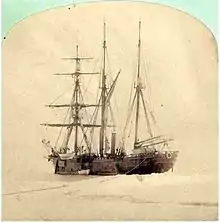Austro-Hungarian North Pole expedition
The Austro-Hungarian North Pole expedition was an expedition that ran from 1872 to 1874 and discovered Franz-Josef Land. According to Julius von Payer and Karl Weyprecht, the leaders of the expedition, its purpose was to explore the Arctic Ocean to the North of Russia and ideally to find the Northeast Passage.[1]:1[2][3]:2 Weyprecht also hoped that the exploration of this area could lead to future expeditions being able to reach the North Pole by sea.[4] The expedition actually explored the region northwest of Novaya Zemlya. The estimated total costs of 175,000 florins were financed by Austro-Hungarian nobles. The two main financial contributors were Count Johann Nepomuk Wilczek (1837–1922) and Hungarian Count Ödön Zichy (1811–1894)

The main ship was the Tegetthoff, named for the Austrian Admiral Wilhelm von Tegetthoff, under whom Weyprecht served. The ship was built by Teklenborg & Beurmann in Bremerhaven. It was a three-masted barkentine of 220 tons, 38.34 m long, with a 100 horsepower (75 kW) steam engine.[3]:3 The crew came from all over Austria-Hungary, especially (12 of them were Croats) from Istria and Dalmatia.[3]:4f
Journey

The Tegetthoff with her crew of 24 left Tromsø, Norway in July 1872.[3]:5 At the end of August she got locked in pack ice north of Novaya Zemlya and drifted to hitherto unknown polar regions.[1]:2,6 While drifting, the explorers discovered an archipelago which they named Franz-Josef Land after Austro-Hungarian Emperor Franz Joseph I.[1]:12 Payer led several sledge expeditions to explore the new-discovered lands, on one of them reaching 81° 50′ North.[1]:8–14
In February 1874 Weyprecht and Payer had decided to abandon the ice-locked ship after completing the sledge expeditions.[3]:190 In May 1874 they left the ship and tried to reach Novaya Zemlya by sledges and boats.[3]:386 On 14 August 1874 the expedition reached the open sea and later Novaya Zemlya where they were rescued by a Russian fishing vessel.[1]:18 On 3 September they reached Vardø in Finnmark, Northern Norway.[1]:18f
The expedition returned to Austria by coastal steamer from Vardø and by train from Hamburg. On the journey they were met by crowds and invited to dinners hosted by local dignitaries and geographical societies in Norway, Sweden and Germany. They entered Vienna in triumph, welcomed, according to contemporary newspaper reports, by hundreds of thousands of people.[5] Further festivities followed throughout Austro-Hungary as the individual explorers returned to their homes.[6]
Significance
The expedition's discoveries and experiences made a significant contribution to polar science, especially the discovery of the Northeast passage by Adolf Erik Nordenskiöld. They also gave an impetus to International Polar Years, meaning a shift from sports-like races of single expeditions to worldwide scientific cooperation in exploring the polar regions.
The expedition yielded various results in the fields of meteorology, astronomy, geodesy, magnetism, zoology, and sightings of Aurora Borealis. They were published by the Academy of Sciences in 1878. There is a book (The Austro-Hungarian North Pole Expedition 1872-74[3]) and paintings by Payer - probably the only paintings of a polar expedition created by the explorer himself.
The expedition was selected as the main motif for the Austrian Admiral Tegetthoff Ship and The Polar Expedition commemorative coin minted on June 8, 2005. The reverse side of the coin shows two explorers in Arctic gear with the frozen ship behind them.
Bibliography
- Österreichische Nationalbibliothek, Hundert Jahre Franz Josef's Land: Katalog einer Ausstellung im Prunksaal der Österreichischen Nationalbibliothek (Vienna 1973).
- Julius von Payer New Lands within the Arctic Circle (1876)
- Andreas Pöschek: Geheimnis Nordpol. Die Österreichisch-Ungarische Nordpolexpedition 1872-1874. - Wien: 1999 (download as PDF)
- Johan Schimanski and Ulrike Spring, Passagiere des Eises. Polarhelden und arktische Diskurse 1874, Wien: Böhlau 2015, ISBN 978-3-205-79606-0.
- Karl Weyprecht, Die Metamorphosen des Polareises. Österr.-Ung. Arktische Expedition 1872-1874 (The Metamorphosis of Polar Ice. The Austro-Hungarian Polar Expedition of 1872–1874)
Further reading
See also
References
- Payer, Julius (1875). "The Austro-Hungarian Polar Expedition of 1872-4". The Journal of the Royal Geographical Society of London. 45: 1–19. doi:10.2307/1798702. Retrieved 27 December 2020.
- Weyprecht, Carl (1875). "Scientific Work of the Second Austro-Hungarian Polar Expedition, 1872-4". The Journal of the Royal Geographical Society of London. 45: 19–33. doi:10.2307/1798703. Retrieved 27 December 2020.
- Payer, Julius (1876). Die österreichisch-ungarische Nordpol-Expedition in den Jahren 1872 - 1874 : nebst einer Skizze der zweiten deutschen Nordpol-Expedition 1869 - 1870 und der Polar-Expedition von 1871. Vienna: Hölder.
- Weyprecht, Carl (1871). "Bericht über die Polarexpedition an die kaiserliche Akademie der Wissenschaften". Mittheilungen der kaiserlich-königlichen Geographischen Gesellschaft. 14: 545–555. Retrieved 28 December 2020.
- "The Austrian arctic expedition", in The Times 24 September 1874 p3.
- Johan Schimanski and Ulrike Spring: Passagiere des Eises. Polarhelden und arktische Diskurse 1874. Wien: Böhlau, 2015.
